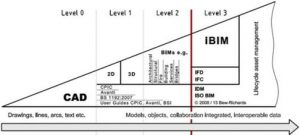BIM Level 2
BIM Level 2 is the implementation of Building Information Management

Image courtesy of Professor Mervyn Richard OBE
Building information modelling (BIM) utilises information-rich models through collaborative working processes in order to improve the quality of information provided at the design, construction and operational phases to save costs by eliminating waste.
BIM was developed initially as a response to the UK Government requiring better control of information on its centrally funded schemes to provide best value following a number of successful case studies. However, the benefits of BIM have been demonstrated outside of central government and as such BIM is being adopted across the industry.
In 2008 a diagram was developed based on the different maturity levels of BIM. This was then used to establish what standards and practices needed to be developed / updated to allow each maturity level to be adopted. The current focus of the industry is to adopt maturity level 2.
BIM Level 2 Requirements
Following the UK Government target of achieving BIM maturity level 2 by 2016 on all public sector asset procurement, there has been confusion over what are the specific requirements to be met in order to achieve BIM level 2. The requirements to achieve BIM level 2 are outlined within PAS1192-2:2013, which are summarised below.
- Development of information models which reference, federate or exchange information with other models;
- Provision of an Employers Information Requirements (EIR) document with clear definition and decision points;
- Supplier & Supply chain capability assessment;
- Provision of a BIM Execution Plan (BEP) including assigned roles, standard, methods, & procedures and a master information delivery matrix aligned with the project programme;
- Provision of a Common Data Environment;
- Compliance with the documents and standards listed in our Level 2 Documents and Standards section;
- Development of information models utilising database-based software, and analysis software;
